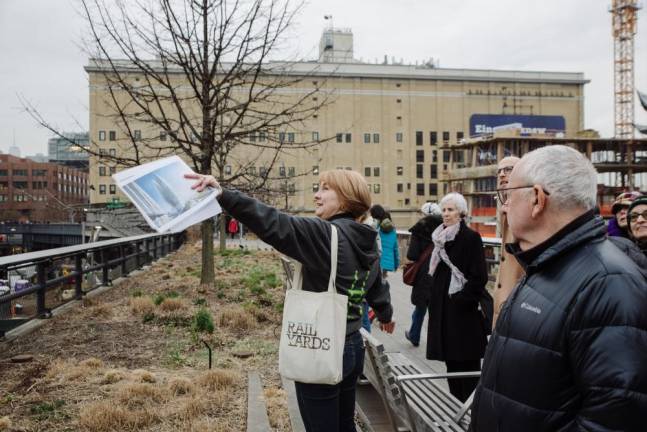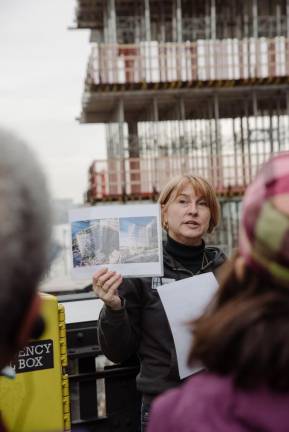Working on the High Line: Where Nature, Art and Design Come Together
Volunteer Coordinator Bridget Gramling explains why this 1.45-mile-long elevated rail structure park is so special.
Even though the High Line park opened in 2009 – just 13 years ago –it quickly became a must-see, iconic and free attraction for native New Yorkers and tourists alike. It is one of my favorite places in the city, and I was lucky enough to speak with Bridget Gramling, the volunteer coordinator, to find out what makes this public park so special to her and everyone who visits.
What is the history of the High Line? How did it come about?
The High Line was part of the West Side Improvement Project back in the 1920s and 1930s. Previously, the trains would run at street level, which caused lots of problems. People and horses would often be struck and killed, and it caused a lot of chaos on the ground. So between 1929 and 1934, the raised structure was built. The trains couldn’t run underground because the area was built on landfill. At the time, it went from St. John’s Terminal Warehouse down on Houston Street up to about 36th Street, after which the trains would disappear back underground.
Built in the middle of the Depression, this was a massive project with the goal of getting trains off the street. They even created openings through some buildings to accommodate the trains, while other buildings were constructed around the tracks to straddle the raised structure which allowed the trains to load and unload into various warehouses and factories along the West Side. If you visit the High Line at 14th and 16th Streets, you’ll see that the park structure goes through some of those buildings that still exist today.
As a freight rail line, the High Line was in operation from 1934 to 1980. It carried a variety of things, such as meat to the Meatpacking District, agricultural goods to the factories and warehouses of the industrial West Side, and mail to the Post Office. After the rail line closed, the nonprofit Friends of the High Line was founded by neighborhood residents Robert Hammond and Joshua David in 1999 to prevent the historical rail track from being demolished.
With the support of Mayor Bloomberg, the City Council and the New York City Department of Parks and Recreation, the High Line transformed into a public space where everyone, New Yorkers and visitors alike, can come to experience the intersection of nature, art, and design. The High Line park officially opened in 2009 and since then has become one of New York’s most beloved attractions.
Describe your roles as the volunteer coordinator and what is it that you do.
My main role is as the volunteer coordinator is to keep the volunteers up to date with everything going on with the High Line. Many of the programs that we offered, such as tours and special events for schools and other organizations unfortunately had to be shut down due to the pandemic in the spring of 2020. As of winter 2020, though, we’ve resumed our public and private tours, brought back our volunteer gardeners, and opened up our greeter cart so the public can interact with our volunteers.
Another part of my job is coordinating schedules and making sure that all the various volunteer shifts are covered. Additionally, issues often arise, so I make sure that I’m always available to help our volunteers the best I can so they feel special and supported. In addition to the team of full- and part-time staff, the High Line currently has about 150 volunteers, many of whom are great friends. All of our volunteers are wonderful, amazing people who truly support the park.
What is your favorite part of the High Line?
Along with being the volunteer coordinator, I’ve been volunteering for the High Line for almost a decade so I know the park very well. I would say one favorite spot is on 16th Street, where a piece of the High Line juts out. The trains used to go into the Merchants Refrigerating Warehouse there, which is now a Manhattan Mini Storage facility. You can see the three feet of concrete and iron that make up the structure of the High Line. If you look to the other side however, you see the beautiful, Art Deco designs that the railroad commissioned despite the fact that it was the height of the Depression. At that spot, you can see the High Line as both a structure and as a piece of art. You can also look down onto one of the amazing gardens designed by Piet Oudolf, the planting designer for the High Line.
How do you recommend seeing the park?
I recommend starting at the south end at Gansevoort and Washington streets and walking north. You’ll walk through the Chelsea Market Passage, which is attached to one of the old Nabisco factories. At 16th Street, you can see the Art Deco designs on the High Line structure I was talking about. At 17th Street, there’s a group of trees with a beautiful seating area with glass windows. If you stand in that maple grove and look south, you can see the Statue of Liberty. At 30th Street, you’ll end up at Hudson Yards, New York’s newest neighborhood. While I’ve been a docent for a long time, I’m still discovering the High Line myself. It really is the gift that keeps on giving.
How can people become involved?
Becoming involved is actually very easy. Friends of the High Line is a nonprofit organization that oversees public programming, public art, maintenance, and operations for the High Line. We raise nearly 100% of the High Line’s annual budget. You can support the park by becoming a member or making an online donation.
Going to the High Line is completely free and is a great way to get out of the house. So the next time you have nothing to do or want to get your kids off their phones for a few hours, go down to the Meatpacking district, have some brunch, and go on a tour of the High Line. We promise, you won’t regret it.
Visit the High Line website here: https://www.thehighline.org
Join Friends of the High Line here: https://www.thehighline.org/membership/
Lea Efran is a NYC high school sophomore. She plays volleyball, does jiu-jitsu and is a Stone Soup Magazine honoree.

